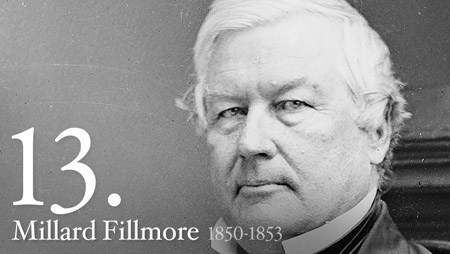
Millard Fillmore, the 13th President of the United States, served from July 9, 1850, to March 4, 1853. Ascending to the presidency after the sudden death of Zachary Taylor, Fillmore faced a nation deeply divided over issues such as slavery and sectionalism. This article provides an in-depth timeline of Fillmore’s presidency, detailing the key dates and events that defined his time in office.
Ascension to the Presidency: July 1850
- July 9, 1850: Millard Fillmore becomes the 13th President of the United States following the death of President Zachary Taylor. Fillmore’s ascension comes at a critical juncture as the nation grapples with intense debates over the future of slavery in new territories.
- July 10, 1850: Fillmore is officially sworn in as president. He quickly sets about assembling his administration, making significant changes to Taylor’s cabinet. Fillmore appoints Daniel Webster as Secretary of State, a move that signifies his intent to support the Compromise of 1850.
The Compromise of 1850: July – September 1850
- July 1850: Fillmore signals his support for the Compromise of 1850, a series of legislative measures designed to resolve the slavery issue and prevent the secession of Southern states. The compromise, crafted by Senator Henry Clay, aims to balance the interests of free and slave states.
- September 9, 1850: Fillmore signs the first of the compromise bills into law. This includes the admission of California as a free state and the establishment of territorial governments in New Mexico and Utah without restrictions on slavery.
- September 18, 1850: Fillmore signs the Fugitive Slave Act, a highly controversial component of the Compromise of 1850. The law mandates the return of escaped slaves to their owners and imposes harsh penalties on those who aid fugitives. The act provokes strong opposition in the North and deepens sectional tensions.
Domestic Policies and Challenges: 1851
- January 1851: Fillmore addresses Congress, emphasizing the importance of upholding the Compromise of 1850. He advocates for strict enforcement of the Fugitive Slave Act, despite widespread Northern resistance.
- April 1851: The New York City “Christiana Riot” occurs, where a group of African Americans and abolitionists resist the capture of four fugitive slaves. The event highlights the growing Northern defiance against the Fugitive Slave Act and intensifies the national debate over slavery.
- June 1851: Fillmore’s administration faces economic challenges, including a downturn in the economy. He works to stabilize the financial situation by supporting measures to strengthen the national banking system and encourage commerce.
Foreign Policy Initiatives: 1851-1852
- August 1851: Fillmore sends Commodore Matthew Perry to Japan to negotiate the opening of Japanese ports to American trade. This mission ultimately leads to the signing of the Treaty of Kanagawa in 1854, although Fillmore is no longer in office at that time.
- February 1852: Fillmore addresses Congress, highlighting the need for a transcontinental railroad to connect the Eastern and Western United States. He supports initiatives to promote infrastructure development and facilitate westward expansion.
The Election of 1852 and the Decline of the Whig Party
- June 1852: The Whig Party nominates General Winfield Scott for the presidency, bypassing Fillmore for re-nomination. Fillmore’s support for the Fugitive Slave Act and the Compromise of 1850 alienates many Northern Whigs, leading to divisions within the party.
- November 1852: Democrat Franklin Pierce wins the presidential election in a landslide victory over Whig candidate Winfield Scott. The Whig Party’s disintegration accelerates, with internal conflicts over slavery and sectionalism undermining its unity and influence.
The Final Months in Office: Late 1852 – Early 1853
- December 1852: Fillmore delivers his final State of the Union address, reiterating his support for the Compromise of 1850 and the Fugitive Slave Act. He emphasizes the need for national unity and warns against sectionalism.
- January 1853: Fillmore signs a bill establishing the Washington Territory, furthering the expansion of the United States. This move aligns with his commitment to westward expansion and the development of new territories.
End of Presidency and Legacy: March 1853
- March 4, 1853: Millard Fillmore’s presidency officially ends as Franklin Pierce is inaugurated as the 14th President of the United States. Fillmore leaves office with the nation still deeply divided over slavery, but having temporarily averted secession and civil war through the Compromise of 1850.
Post-Presidency and Legacy
- 1854: Fillmore travels to Europe, where he meets with various leaders and observes political developments. He remains active in politics, but his association with the controversial Fugitive Slave Act limits his influence.
- 1856: Fillmore runs for president as the candidate of the Know-Nothing Party, a nativist political movement. He finishes third in the election, with Democrat James Buchanan winning the presidency.
Legacy and Impact
Millard Fillmore’s presidency is marked by significant achievements and enduring controversies:
- Compromise of 1850: Fillmore’s support for the compromise temporarily calms sectional tensions and delays the onset of the Civil War. However, the Fugitive Slave Act remains a deeply divisive and contentious issue.
- Foreign Policy: Fillmore’s initiatives, particularly the opening of Japan to American trade, have long-term implications for U.S. foreign relations and economic expansion.
- Domestic Policy: Fillmore’s focus on infrastructure development and economic stability reflects his commitment to national growth and modernization.
- Whig Party’s Decline: Fillmore’s presidency coincides with the fragmentation and eventual collapse of the Whig Party, a major political realignment that shapes the future of American politics.
Conclusion
Millard Fillmore’s presidency, though brief and often overshadowed by more prominent figures, played a crucial role in navigating the turbulent political landscape of the early 1850s. His efforts to maintain national unity through the Compromise of 1850, support for economic development, and foreign policy initiatives left a lasting impact on the United States. Despite the controversies and challenges, Fillmore’s tenure highlighted the complexities of leadership during a deeply divided era and set the stage for the tumultuous events that would follow in the coming decades.